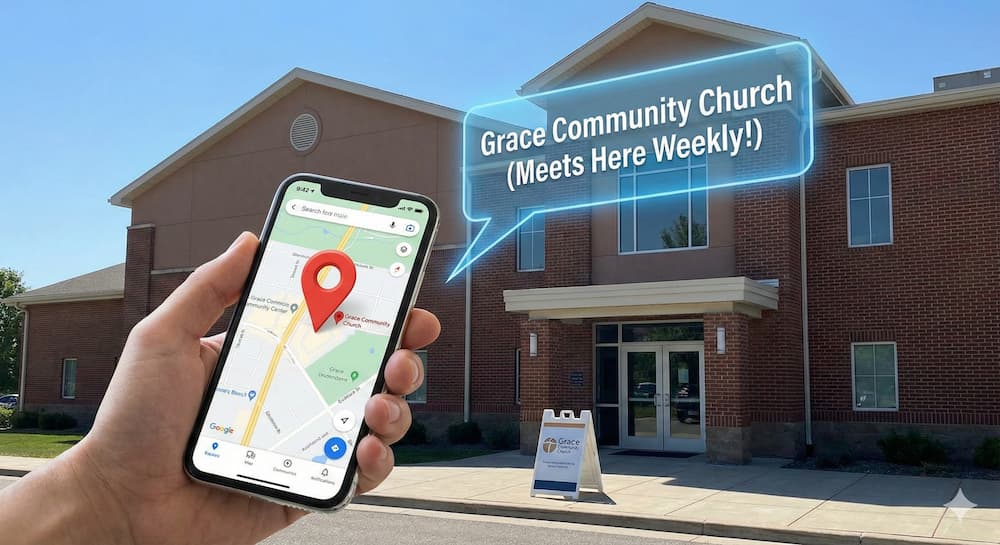How to Create Premium Church Graphics from Scratch in No Time: 7 Tips
Even if you're not a designer, you can employ these 7 tips to take your church graphics from stock to premium in less than 5 minutes.

Your church graphics will communicate one of two things about your church:
(1) We aim to do things well.
(2) We don’t aim to do things well.
Those may sound like exaggerated stakes to hang on your church graphics, but hear me out:
Compare your experience walking into a thrift store with your experience walking into an Apple store.
Every time I’ve walked into an Apple store, I know exactly what I’m looking for, and I know exactly where to find it.
Thrift stores force you to browse, squint, and actively seek out help in order to find what you’re looking for.
The difference in user experience is a direct extension of each company’s design philosophy. Apple aims to design things to make the visitor experience pleasant, intuitive, and beautiful. Thrift stores don’t.
Here’s a game-changing way to think about church graphics:
People who walk into your church doors will find exactly what they’re looking for or they won’t. The same goes for you website.
Use these seven strategies to create stunning church graphics without paying thousands of dollars for a designer.
1. Use no more than three colors
Use one primary color as the base color of your church’s graphics. Whether it’s a particular hue of red, green, yellow, or any other color, stick to that hue as often as possible.
However, when you do vary from that color, make sure to use no more than three colors total (including your base color) throughout all your graphics.
When choosing these two additional colors, follow these two rules:
First, make them opposed on the color wheel. For example, if you were using a bright yellow color, it might be wise to choose the directly opposing two colors on the color wheel, as shown below.

A second rule to follow is to match the hue’s shade. For example, don’t choose a faded green color for your secondary color if your primary color is a bright, neon yellow. If your primary color is slightly faded, pick secondary and tertiary colors that basically match your primary color’s fade.
While there can sometimes be exceptions to these rules, make it a rule to follow them. Only advanced designers can really make the exceptions to these rules work well.
2. Use no more than two fonts
When you add a text overlay to your church graphics, make sure that it is not cluttered with different fonts.
It’s tempting to put your church’s (logo-laden) name, the primary text, and the secondary text on an image, all with different fonts.
This is why it’s important to choose a church font that pairs well with both headline and paragraph fonts—so that it can harmoniously exist side-by-side with any text in any context.
The more fonts you introduce into your church graphic, the more potential there is for the image to appear cluttered and unsightly to your viewer.
3. Visually try to connect with peoples’ hearts to draw people in to the subject matter
Whether you are using a photograph, a linear icon, or plain text on a color, find a way to call to peoples’ emotions in order to draw them into the message you’re communicating.
For example, if your church is running a fundraising campaign for missionaries who focus on reaching unreached people groups, you might want to use bold and large headline lettering that consumes the center of the image to communicate urgency but also possibility.
4. Less is more
Be bold, yet simple, with your sermon graphics, slides, announcements.
When people are looking at an image, you want them to walk away with one idea.
• “Go here.”
• “Click here.”
• “Do this.”
• “Change your thinking.”
People only have room in their minds for one idea at a time. Multitasking is a myth, and “multi-thinking” puts an undue strain on the mind that doesn’t allow people to fully engage with the thought or idea you want them to consider.
Make your design mono-elemental. It’s not that you can’t have more than one graphic element in your church graphic. But you want all of your graphic elements in a single image to point toward a single element that conveys a single concept.
5. Think of what’s most important in your graphic and what you want to draw the eye to
Think of your church graphic like a solar system.
You can have some planets, some ancillary text, some subtle texture to assist in conveying a feel, a style, an aesthetic—but they all must revolve around the “Sun” of your graphic.
What is the central element of your church graphic?
Make each element in your graphic pass this test: “Does this help or distract from the central element of my image?”
6. Visually frame your church graphic
Make sure that there is an unseen border in your graphic.
Not a literal line or thick edge like the border of a painting.
When you place elements in your church image, don’t crowd the edges of the image with text, elements, or design features.
Images with elements too close to the border are unsightly. It’s indicative of amateurish design.
Leave “space” between the elements of your image and the edges.
This doesn’t apply to background elements such as textures, waves, or color blocks, which should extend from end to end, top to bottom, for your entire image.
This simply means that within the dimensions of your image, people should be able to look at a clean, centered element. An invisible border in your image conveys thoughtfulness, organization, and orderliness, which the viewers then assume is true of the message the image communicates.
7. Achieve balance within your church graphic
In other words, don’t put all of the elements of your image in one quadrant of the image.
If you put a weighty element in the top left quadrant of your image, but a symmetrical image in the bottom right of your image.
If you have a vertical line element on the left of your image, balance it with something on the right side.
Left and right, top and bottom.
Imagine that each object in your image has weight, and you don’t want to tip your image too much in one direction, or it will feel imbalanced and off-putting to viewers.
Conclusion
Use these strategies to create clean, professional-looking church graphics that viewers don’t have to think about.
The less your viewers have to think about your image, the more readily they will buy into the message you’re communicating through your image.
Make these design principles the filter through which all staff or volunteers at your church who create images must pass, and you will create a unified, clean user experience for first-time church visitors and long-time members alike.
Sign Up for Product Updates
Your church graphics will communicate one of two things about your church:
(1) We aim to do things well.
(2) We don’t aim to do things well.
Those may sound like exaggerated stakes to hang on your church graphics, but hear me out:
Compare your experience walking into a thrift store with your experience walking into an Apple store.
Every time I’ve walked into an Apple store, I know exactly what I’m looking for, and I know exactly where to find it.
Thrift stores force you to browse, squint, and actively seek out help in order to find what you’re looking for.
The difference in user experience is a direct extension of each company’s design philosophy. Apple aims to design things to make the visitor experience pleasant, intuitive, and beautiful. Thrift stores don’t.
Here’s a game-changing way to think about church graphics:
People who walk into your church doors will find exactly what they’re looking for or they won’t. The same goes for you website.
Use these seven strategies to create stunning church graphics without paying thousands of dollars for a designer.
1. Use no more than three colors
Use one primary color as the base color of your church’s graphics. Whether it’s a particular hue of red, green, yellow, or any other color, stick to that hue as often as possible.
However, when you do vary from that color, make sure to use no more than three colors total (including your base color) throughout all your graphics.
When choosing these two additional colors, follow these two rules:
First, make them opposed on the color wheel. For example, if you were using a bright yellow color, it might be wise to choose the directly opposing two colors on the color wheel, as shown below.

A second rule to follow is to match the hue’s shade. For example, don’t choose a faded green color for your secondary color if your primary color is a bright, neon yellow. If your primary color is slightly faded, pick secondary and tertiary colors that basically match your primary color’s fade.
While there can sometimes be exceptions to these rules, make it a rule to follow them. Only advanced designers can really make the exceptions to these rules work well.
2. Use no more than two fonts
When you add a text overlay to your church graphics, make sure that it is not cluttered with different fonts.
It’s tempting to put your church’s (logo-laden) name, the primary text, and the secondary text on an image, all with different fonts.
This is why it’s important to choose a church font that pairs well with both headline and paragraph fonts—so that it can harmoniously exist side-by-side with any text in any context.
The more fonts you introduce into your church graphic, the more potential there is for the image to appear cluttered and unsightly to your viewer.
3. Visually try to connect with peoples’ hearts to draw people in to the subject matter
Whether you are using a photograph, a linear icon, or plain text on a color, find a way to call to peoples’ emotions in order to draw them into the message you’re communicating.
For example, if your church is running a fundraising campaign for missionaries who focus on reaching unreached people groups, you might want to use bold and large headline lettering that consumes the center of the image to communicate urgency but also possibility.
4. Less is more
Be bold, yet simple, with your sermon graphics, slides, announcements.
When people are looking at an image, you want them to walk away with one idea.
• “Go here.”
• “Click here.”
• “Do this.”
• “Change your thinking.”
People only have room in their minds for one idea at a time. Multitasking is a myth, and “multi-thinking” puts an undue strain on the mind that doesn’t allow people to fully engage with the thought or idea you want them to consider.
Make your design mono-elemental. It’s not that you can’t have more than one graphic element in your church graphic. But you want all of your graphic elements in a single image to point toward a single element that conveys a single concept.
5. Think of what’s most important in your graphic and what you want to draw the eye to
Think of your church graphic like a solar system.
You can have some planets, some ancillary text, some subtle texture to assist in conveying a feel, a style, an aesthetic—but they all must revolve around the “Sun” of your graphic.
What is the central element of your church graphic?
Make each element in your graphic pass this test: “Does this help or distract from the central element of my image?”
6. Visually frame your church graphic
Make sure that there is an unseen border in your graphic.
Not a literal line or thick edge like the border of a painting.
When you place elements in your church image, don’t crowd the edges of the image with text, elements, or design features.
Images with elements too close to the border are unsightly. It’s indicative of amateurish design.
Leave “space” between the elements of your image and the edges.
This doesn’t apply to background elements such as textures, waves, or color blocks, which should extend from end to end, top to bottom, for your entire image.
This simply means that within the dimensions of your image, people should be able to look at a clean, centered element. An invisible border in your image conveys thoughtfulness, organization, and orderliness, which the viewers then assume is true of the message the image communicates.
7. Achieve balance within your church graphic
In other words, don’t put all of the elements of your image in one quadrant of the image.
If you put a weighty element in the top left quadrant of your image, but a symmetrical image in the bottom right of your image.
If you have a vertical line element on the left of your image, balance it with something on the right side.
Left and right, top and bottom.
Imagine that each object in your image has weight, and you don’t want to tip your image too much in one direction, or it will feel imbalanced and off-putting to viewers.
Conclusion
Use these strategies to create clean, professional-looking church graphics that viewers don’t have to think about.
The less your viewers have to think about your image, the more readily they will buy into the message you’re communicating through your image.
Make these design principles the filter through which all staff or volunteers at your church who create images must pass, and you will create a unified, clean user experience for first-time church visitors and long-time members alike.
podcast transcript
Your church graphics will communicate one of two things about your church:
(1) We aim to do things well.
(2) We don’t aim to do things well.
Those may sound like exaggerated stakes to hang on your church graphics, but hear me out:
Compare your experience walking into a thrift store with your experience walking into an Apple store.
Every time I’ve walked into an Apple store, I know exactly what I’m looking for, and I know exactly where to find it.
Thrift stores force you to browse, squint, and actively seek out help in order to find what you’re looking for.
The difference in user experience is a direct extension of each company’s design philosophy. Apple aims to design things to make the visitor experience pleasant, intuitive, and beautiful. Thrift stores don’t.
Here’s a game-changing way to think about church graphics:
People who walk into your church doors will find exactly what they’re looking for or they won’t. The same goes for you website.
Use these seven strategies to create stunning church graphics without paying thousands of dollars for a designer.
1. Use no more than three colors
Use one primary color as the base color of your church’s graphics. Whether it’s a particular hue of red, green, yellow, or any other color, stick to that hue as often as possible.
However, when you do vary from that color, make sure to use no more than three colors total (including your base color) throughout all your graphics.
When choosing these two additional colors, follow these two rules:
First, make them opposed on the color wheel. For example, if you were using a bright yellow color, it might be wise to choose the directly opposing two colors on the color wheel, as shown below.

A second rule to follow is to match the hue’s shade. For example, don’t choose a faded green color for your secondary color if your primary color is a bright, neon yellow. If your primary color is slightly faded, pick secondary and tertiary colors that basically match your primary color’s fade.
While there can sometimes be exceptions to these rules, make it a rule to follow them. Only advanced designers can really make the exceptions to these rules work well.
2. Use no more than two fonts
When you add a text overlay to your church graphics, make sure that it is not cluttered with different fonts.
It’s tempting to put your church’s (logo-laden) name, the primary text, and the secondary text on an image, all with different fonts.
This is why it’s important to choose a church font that pairs well with both headline and paragraph fonts—so that it can harmoniously exist side-by-side with any text in any context.
The more fonts you introduce into your church graphic, the more potential there is for the image to appear cluttered and unsightly to your viewer.
3. Visually try to connect with peoples’ hearts to draw people in to the subject matter
Whether you are using a photograph, a linear icon, or plain text on a color, find a way to call to peoples’ emotions in order to draw them into the message you’re communicating.
For example, if your church is running a fundraising campaign for missionaries who focus on reaching unreached people groups, you might want to use bold and large headline lettering that consumes the center of the image to communicate urgency but also possibility.
4. Less is more
Be bold, yet simple, with your sermon graphics, slides, announcements.
When people are looking at an image, you want them to walk away with one idea.
• “Go here.”
• “Click here.”
• “Do this.”
• “Change your thinking.”
People only have room in their minds for one idea at a time. Multitasking is a myth, and “multi-thinking” puts an undue strain on the mind that doesn’t allow people to fully engage with the thought or idea you want them to consider.
Make your design mono-elemental. It’s not that you can’t have more than one graphic element in your church graphic. But you want all of your graphic elements in a single image to point toward a single element that conveys a single concept.
5. Think of what’s most important in your graphic and what you want to draw the eye to
Think of your church graphic like a solar system.
You can have some planets, some ancillary text, some subtle texture to assist in conveying a feel, a style, an aesthetic—but they all must revolve around the “Sun” of your graphic.
What is the central element of your church graphic?
Make each element in your graphic pass this test: “Does this help or distract from the central element of my image?”
6. Visually frame your church graphic
Make sure that there is an unseen border in your graphic.
Not a literal line or thick edge like the border of a painting.
When you place elements in your church image, don’t crowd the edges of the image with text, elements, or design features.
Images with elements too close to the border are unsightly. It’s indicative of amateurish design.
Leave “space” between the elements of your image and the edges.
This doesn’t apply to background elements such as textures, waves, or color blocks, which should extend from end to end, top to bottom, for your entire image.
This simply means that within the dimensions of your image, people should be able to look at a clean, centered element. An invisible border in your image conveys thoughtfulness, organization, and orderliness, which the viewers then assume is true of the message the image communicates.
7. Achieve balance within your church graphic
In other words, don’t put all of the elements of your image in one quadrant of the image.
If you put a weighty element in the top left quadrant of your image, but a symmetrical image in the bottom right of your image.
If you have a vertical line element on the left of your image, balance it with something on the right side.
Left and right, top and bottom.
Imagine that each object in your image has weight, and you don’t want to tip your image too much in one direction, or it will feel imbalanced and off-putting to viewers.
Conclusion
Use these strategies to create clean, professional-looking church graphics that viewers don’t have to think about.
The less your viewers have to think about your image, the more readily they will buy into the message you’re communicating through your image.
Make these design principles the filter through which all staff or volunteers at your church who create images must pass, and you will create a unified, clean user experience for first-time church visitors and long-time members alike.
VIDEO transcript
Your church graphics will communicate one of two things about your church:
(1) We aim to do things well.
(2) We don’t aim to do things well.
Those may sound like exaggerated stakes to hang on your church graphics, but hear me out:
Compare your experience walking into a thrift store with your experience walking into an Apple store.
Every time I’ve walked into an Apple store, I know exactly what I’m looking for, and I know exactly where to find it.
Thrift stores force you to browse, squint, and actively seek out help in order to find what you’re looking for.
The difference in user experience is a direct extension of each company’s design philosophy. Apple aims to design things to make the visitor experience pleasant, intuitive, and beautiful. Thrift stores don’t.
Here’s a game-changing way to think about church graphics:
People who walk into your church doors will find exactly what they’re looking for or they won’t. The same goes for you website.
Use these seven strategies to create stunning church graphics without paying thousands of dollars for a designer.
1. Use no more than three colors
Use one primary color as the base color of your church’s graphics. Whether it’s a particular hue of red, green, yellow, or any other color, stick to that hue as often as possible.
However, when you do vary from that color, make sure to use no more than three colors total (including your base color) throughout all your graphics.
When choosing these two additional colors, follow these two rules:
First, make them opposed on the color wheel. For example, if you were using a bright yellow color, it might be wise to choose the directly opposing two colors on the color wheel, as shown below.

A second rule to follow is to match the hue’s shade. For example, don’t choose a faded green color for your secondary color if your primary color is a bright, neon yellow. If your primary color is slightly faded, pick secondary and tertiary colors that basically match your primary color’s fade.
While there can sometimes be exceptions to these rules, make it a rule to follow them. Only advanced designers can really make the exceptions to these rules work well.
2. Use no more than two fonts
When you add a text overlay to your church graphics, make sure that it is not cluttered with different fonts.
It’s tempting to put your church’s (logo-laden) name, the primary text, and the secondary text on an image, all with different fonts.
This is why it’s important to choose a church font that pairs well with both headline and paragraph fonts—so that it can harmoniously exist side-by-side with any text in any context.
The more fonts you introduce into your church graphic, the more potential there is for the image to appear cluttered and unsightly to your viewer.
3. Visually try to connect with peoples’ hearts to draw people in to the subject matter
Whether you are using a photograph, a linear icon, or plain text on a color, find a way to call to peoples’ emotions in order to draw them into the message you’re communicating.
For example, if your church is running a fundraising campaign for missionaries who focus on reaching unreached people groups, you might want to use bold and large headline lettering that consumes the center of the image to communicate urgency but also possibility.
4. Less is more
Be bold, yet simple, with your sermon graphics, slides, announcements.
When people are looking at an image, you want them to walk away with one idea.
• “Go here.”
• “Click here.”
• “Do this.”
• “Change your thinking.”
People only have room in their minds for one idea at a time. Multitasking is a myth, and “multi-thinking” puts an undue strain on the mind that doesn’t allow people to fully engage with the thought or idea you want them to consider.
Make your design mono-elemental. It’s not that you can’t have more than one graphic element in your church graphic. But you want all of your graphic elements in a single image to point toward a single element that conveys a single concept.
5. Think of what’s most important in your graphic and what you want to draw the eye to
Think of your church graphic like a solar system.
You can have some planets, some ancillary text, some subtle texture to assist in conveying a feel, a style, an aesthetic—but they all must revolve around the “Sun” of your graphic.
What is the central element of your church graphic?
Make each element in your graphic pass this test: “Does this help or distract from the central element of my image?”
6. Visually frame your church graphic
Make sure that there is an unseen border in your graphic.
Not a literal line or thick edge like the border of a painting.
When you place elements in your church image, don’t crowd the edges of the image with text, elements, or design features.
Images with elements too close to the border are unsightly. It’s indicative of amateurish design.
Leave “space” between the elements of your image and the edges.
This doesn’t apply to background elements such as textures, waves, or color blocks, which should extend from end to end, top to bottom, for your entire image.
This simply means that within the dimensions of your image, people should be able to look at a clean, centered element. An invisible border in your image conveys thoughtfulness, organization, and orderliness, which the viewers then assume is true of the message the image communicates.
7. Achieve balance within your church graphic
In other words, don’t put all of the elements of your image in one quadrant of the image.
If you put a weighty element in the top left quadrant of your image, but a symmetrical image in the bottom right of your image.
If you have a vertical line element on the left of your image, balance it with something on the right side.
Left and right, top and bottom.
Imagine that each object in your image has weight, and you don’t want to tip your image too much in one direction, or it will feel imbalanced and off-putting to viewers.
Conclusion
Use these strategies to create clean, professional-looking church graphics that viewers don’t have to think about.
The less your viewers have to think about your image, the more readily they will buy into the message you’re communicating through your image.
Make these design principles the filter through which all staff or volunteers at your church who create images must pass, and you will create a unified, clean user experience for first-time church visitors and long-time members alike.


















.jpg)









